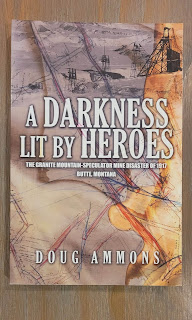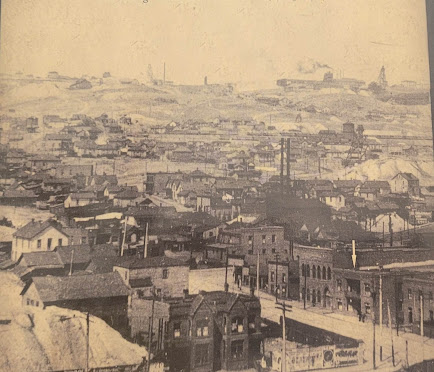One of the hardest parts of solving a 99-year-old murder is trying to stay focused. The murder of Frank Little wasn't a robbery. It wasn't an angry husband or spouse. It was a very deliberate killing. It was meant to send a message. Let this be a message to anyone who comes to Butte and talks about mineworker's rights and strikes. You are going to be killed just like Frank was. So, a thorough examination of Frank Little was where I started back in 2016.
I knew the history. I knew that Frank was a union organizer. I knew that his employer sent him from a mine in Bisbee, Az to Butte. I knew that the United Workers of the World or the Wobblies, were commonly viewed as socialists although I think that is inaccurate. I couldn't grasp the threat level. What did Frank do that was so bad that persons unknown would kidnap him in the middle of the night and brutally murder him?
This is where we need context. We need to paint that picture to fully understand why Frank Little was murdered.
The Miners
People from all over the world came to America. They came for freedom. They came for opportunity. There was no greater example of this than Butte, Montana. The miners came from everywhere but mostly, eastern and western Europe and Scandinavia. Most were uneducated in the formal sense. Many could not speak English. But the Irish could. The Irish, of all the nationalities in Butte, were vastly overrepresented. This was due mostly to the efforts of the great copper king and Irish immigrant, Marcus Daly. Marcus Daly came to Butte, bought the Alice mine property in Walkerville, and discovered copper in it. The ore body was enormous. Daly sold the Alice and moved his operations to the absolute center of the ore body. The Anaconda mine on the Anaconda Road. Underground mining required huge amounts of physical labor. Soon there were claims and mines all over the hill. Hundreds of them.
Thousands upon thousands of miners came to Butte looking for the American dream. They slapped tiny little houses together all over the hill and walked to work at the mines. They worked 12-hour days, 6 days a week. It was horrible, dangerous work, with little oxygen a mile underground. Safety concerns were routinely ignored. Miners died by the hundreds and soon, by the thousands. They died in cave-ins, accidents, and falls. They died in fires. They died of black lung. Butte cemeteries are vast.
So miners had to fight. They had to fight for safety. They had to fight for reduced hours and increasing wages. They shared great adversity and they fought back. They fought the Company with unions. They fought with strikes.
By the time the Copper Kings sold out, the miners found themselves with a whole new adversary. The Anaconda Company was vicious and ruthless. They were capitalists and robber barons of the first order. Killing miners simply meant hiring new ones. If Marcus Daly was loved, the Anaconda Company was feared and hated.
By the time World War I had started in 1914, Butte miners were up in arms. Not only were they angry with the Company over a litany of issues but they detested the war in Europe. The Irish had fled Ireland to escape British rule. Many immigrants had fled for similar issues. They weren't about to support a war among countries they disliked and cared little about. Many were angry when the United States chose to enter the war in March of 1917. The miners were already pissed.
And then something really bad happened.
The Granite Mountain/Speculator Mine Disaster
On Jun 8th, 1917, a fire broke out in the Granite Mountain Mine after a cable had been dropped in the shaft. Workers were sent to retrieve the cable some 2500 feet underground. The cable was encased in flammable grease and when they found it, it was all tangled up. As Ernest Sullau attempted to wrestle the damaged cable free, his carbide lamp lit the cable grease which touched the timbers in the mine.
The Granite Mountain mine was connected to the Speculator Mine. Their shafts were parallel to each other. Both mine shafts began filling with smoke. Miners were quite literally choking to death, scrambling for clean air in various tunnels, and building bulkheads in dead end drifts. They could not get out.
Horns sounded all over the hill. The citizens of Butte knew something horrible had happened. By the time it was all over, 168 miners had been killed in the worst hard rock mining disaster the world had ever known.
If killing 168 miners at once were not bad enough, the Company bore no responsibility. They didn't help with the cost of funerals. They didn't reach out to widows and children. They offered no financial support to the families that found themselves without husbands and fathers, without money or support, without groceries and rent. This while the Anaconda Company made a million dollars a day.
It was a callous, horrible response. Butte miners had become combustible. Into this sweeping anger and hatred for the Company, amidst union fights and strikes, all hell was breaking loose. Frank Little, labor organizer for the Industrial Workers of the World, was about to step into purgatory. It was July 12th, 1917. Frank Little was about to take his eternal walk. He had less than 3 weeks to live.
(I have read two fantastic books on the Granite Mountain/Speculator disaster. The latest is called "A Darkness Lit By Heroes." It is a fantastic body of work, very well written. I could not put it down. The other book is called Fire and Brimstone, also very good)
Frank Little
In the summer of 2016, I wanted to capture the emotions that Frank Little would encounter when he stepped off that train in July, some 99 years ago. Clearly that would be impossible, but I had to understand the context that existed back then. What kind of charged atmosphere leads to such a cruel and desperate act?
The Butte papers painted that picture for me. They had the microfiche and the readers in the Butte Library and I am grateful for that. I spent a few days in the library reading old newspapers and a few days up in the Butte Archives.
It is worth remembering that virtually all newspapers were owned by the Anaconda Company at the time except for William Dunn's, "Strike Bulletin." Therefore, you are reading somewhat filtered propaganda, just the way the Company wanted you to read it. I was highly dismissive of the suspect names and theories they espoused. Completely untrustworthy and meant to confuse readers.
This is what I can tell you about Frank Little. He arrived in Butte with a broken leg. He rented a room in a boarding house on N Wyoming, just south of the Anaconda Road. He gave passionate speeches to the miners. He did this every day and hobbled home. He was gaining serious traction among the miners, most of whom were all doing a slow burn over the way the Company was treating them. They hated the war. Frank hated the war too.
The Company goons tried to paint Frank Little as a communist sympathizer. They tried to chip away at the credibility he was gaining. And they were losing.
The more Frank spoke, the more the miners liked him. People began to worry about Frank. A local barber, Con Lowney, warned Frank that he was going to be killed. Frank shrugged it off. He had heard this all before.
It was about 3 a.m. on the morning of August 1, that a black Cadillac chugged up the steep grade of Wyoming Street. It had seating for six people. The car stopped in front of Frank's boarding house. Five men in masks went into the boarding house, one stayed with the car. After kicking one door open, they were confronted by the boarding house owner and her son. They demanded to know where Frank Little was sleeping. They said they had a warrant for him. The man doing all the talking was short and stocky. He was waving a police revolver. They rousted Frank Little, beat him up and dragged him out of the boarding house and into the waiting car. The seven of them proceeded up the hill to the intersection of the Anaconda Road, about 300 feet away. They tied Frank to the back bumper with a length of rope. They dragged him away.
This was witnessed by two men standing outside O'Briens Bar across the street from the boarding house. O'Briens is long gone.
Frank Little was found about 3 hours later. He had been hanged from a train trestle west of Montana Street, a little over a mile away. He had a cryptic note attached to his body with a numeric reference attributed to the Montana Vigilantes. His body was discovered by a man walking to work.
Frank's body was taken down. His kneecaps had been nearly scraped off as he was being dragged through the streets.
Norah Byrne, the owner of the boarding house, did not immediately report the crime believing the men to be police officers. It was only after discussing the masks they wore (with her son) that she decided to report the incident to police. As it turns out, in the days and weeks that followed, the Butte cops didn't seem too concerned about it.
This was the note found on Little's body. The reference to 3-7-77 is a number the Montana Vigilantes used. The Montana Highway Patrol have those numbers on their patch. The exact meaning of those numbers has been debated over the years. I was not that concerned about what the numbers meant. What was important to me was why they were used. There had to be a connection and there was. I stumbled onto it years later. The bottom line on the note represents the last initials of other union organizers. The "L" for Little has been circled. Next up, "D" for William Dunn.
Little's funeral was the biggest in Montana history. Some say there were 7,000 people in attendance.
The grave is several miles away. Note the street surface. Granite Street.
Frank Little was killed because he threatened the Anaconda Company. They were making a million dollars a day. Frank Little was gaining traction and credibility with miners. The Company had already weathered the Granite Mountain disaster, they had weathered a partial strike which was continuing, and they certainly weren't going to tolerate a full scale, citywide strike instigated by Little. You couldn't reason with or intimidate Frank. He wasn't going to stop. So the only thing you could do was kill him and use his death to intimidate anyone else thinking of stepping up and taking his place.
It became pretty clear to me that the Company had him killed. They had tremendous motive. So if you wanted someone killed, who would order that and who would carry it out?








